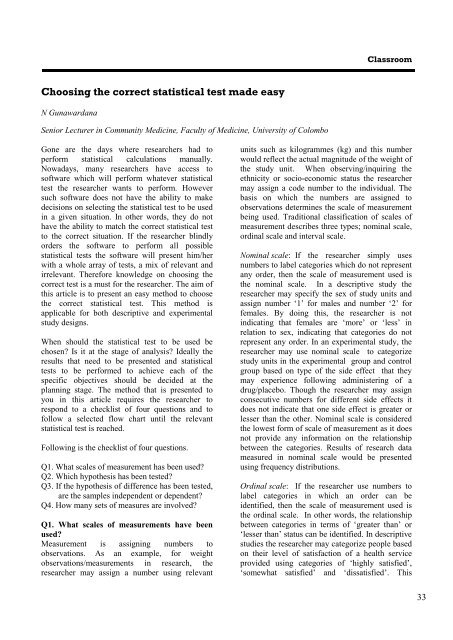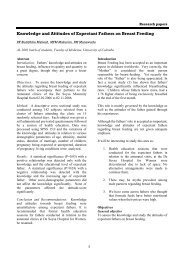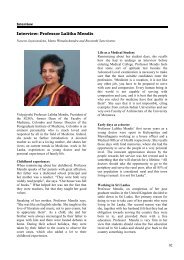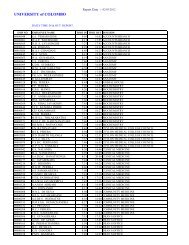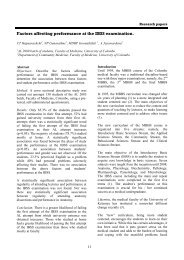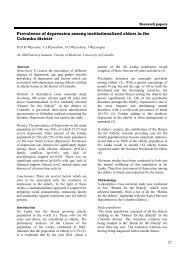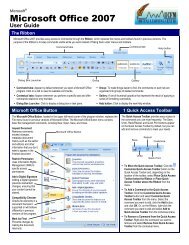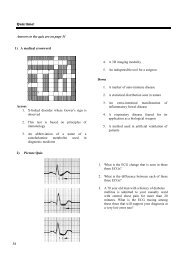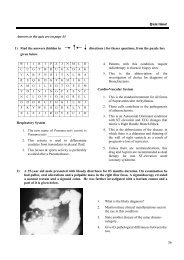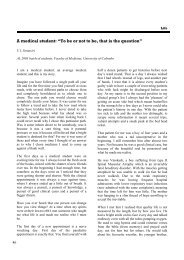Choosing the correct statistical test made easy - Faculty of Medicine ...
Choosing the correct statistical test made easy - Faculty of Medicine ...
Choosing the correct statistical test made easy - Faculty of Medicine ...
Create successful ePaper yourself
Turn your PDF publications into a flip-book with our unique Google optimized e-Paper software.
Classroom<br />
<strong>Choosing</strong> <strong>the</strong> <strong>correct</strong> <strong>statistical</strong> <strong>test</strong> <strong>made</strong> <strong>easy</strong><br />
N Gunawardana<br />
Senior Lecturer in Community <strong>Medicine</strong>, <strong>Faculty</strong> <strong>of</strong> <strong>Medicine</strong>, University <strong>of</strong> Colombo<br />
Gone are <strong>the</strong> days where researchers had to<br />
perform <strong>statistical</strong> calculations manually.<br />
Nowadays, many researchers have access to<br />
s<strong>of</strong>tware which will perform whatever <strong>statistical</strong><br />
<strong>test</strong> <strong>the</strong> researcher wants to perform. However<br />
such s<strong>of</strong>tware does not have <strong>the</strong> ability to make<br />
decisions on selecting <strong>the</strong> <strong>statistical</strong> <strong>test</strong> to be used<br />
in a given situation. In o<strong>the</strong>r words, <strong>the</strong>y do not<br />
have <strong>the</strong> ability to match <strong>the</strong> <strong>correct</strong> <strong>statistical</strong> <strong>test</strong><br />
to <strong>the</strong> <strong>correct</strong> situation. If <strong>the</strong> researcher blindly<br />
orders <strong>the</strong> s<strong>of</strong>tware to perform all possible<br />
<strong>statistical</strong> <strong>test</strong>s <strong>the</strong> s<strong>of</strong>tware will present him/her<br />
with a whole array <strong>of</strong> <strong>test</strong>s, a mix <strong>of</strong> relevant and<br />
irrelevant. Therefore knowledge on choosing <strong>the</strong><br />
<strong>correct</strong> <strong>test</strong> is a must for <strong>the</strong> researcher. The aim <strong>of</strong><br />
this article is to present an <strong>easy</strong> method to choose<br />
<strong>the</strong> <strong>correct</strong> <strong>statistical</strong> <strong>test</strong>. This method is<br />
applicable for both descriptive and experimental<br />
study designs.<br />
When should <strong>the</strong> <strong>statistical</strong> <strong>test</strong> to be used be<br />
chosen? Is it at <strong>the</strong> stage <strong>of</strong> analysis? Ideally <strong>the</strong><br />
results that need to be presented and <strong>statistical</strong><br />
<strong>test</strong>s to be performed to achieve each <strong>of</strong> <strong>the</strong><br />
specific objectives should be decided at <strong>the</strong><br />
planning stage. The method that is presented to<br />
you in this article requires <strong>the</strong> researcher to<br />
respond to a checklist <strong>of</strong> four questions and to<br />
follow a selected flow chart until <strong>the</strong> relevant<br />
<strong>statistical</strong> <strong>test</strong> is reached.<br />
Following is <strong>the</strong> checklist <strong>of</strong> four questions.<br />
Q1. What scales <strong>of</strong> measurement has been used?<br />
Q2. Which hypo<strong>the</strong>sis has been <strong>test</strong>ed?<br />
Q3. If <strong>the</strong> hypo<strong>the</strong>sis <strong>of</strong> difference has been <strong>test</strong>ed,<br />
are <strong>the</strong> samples independent or dependent?<br />
Q4. How many sets <strong>of</strong> measures are involved?<br />
Q1. What scales <strong>of</strong> measurements have been<br />
used?<br />
Measurement is assigning numbers to<br />
observations. As an example, for weight<br />
observations/measurements in research, <strong>the</strong><br />
researcher may assign a number using relevant<br />
units such as kilogrammes (kg) and this number<br />
would reflect <strong>the</strong> actual magnitude <strong>of</strong> <strong>the</strong> weight <strong>of</strong><br />
<strong>the</strong> study unit. When observing/inquiring <strong>the</strong><br />
ethnicity or socio-economic status <strong>the</strong> researcher<br />
may assign a code number to <strong>the</strong> individual. The<br />
basis on which <strong>the</strong> numbers are assigned to<br />
observations determines <strong>the</strong> scale <strong>of</strong> measurement<br />
being used. Traditional classification <strong>of</strong> scales <strong>of</strong><br />
measurement describes three types; nominal scale,<br />
ordinal scale and interval scale.<br />
Nominal scale: If <strong>the</strong> researcher simply uses<br />
numbers to label categories which do not represent<br />
any order, <strong>the</strong>n <strong>the</strong> scale <strong>of</strong> measurement used is<br />
<strong>the</strong> nominal scale. In a descriptive study <strong>the</strong><br />
researcher may specify <strong>the</strong> sex <strong>of</strong> study units and<br />
assign number ‘1’ for males and number ‘2’ for<br />
females. By doing this, <strong>the</strong> researcher is not<br />
indicating that females are ‘more’ or ‘less’ in<br />
relation to sex, indicating that categories do not<br />
represent any order. In an experimental study, <strong>the</strong><br />
researcher may use nominal scale to categorize<br />
study units in <strong>the</strong> experimental group and control<br />
group based on type <strong>of</strong> <strong>the</strong> side effect that <strong>the</strong>y<br />
may experience following administering <strong>of</strong> a<br />
drug/placebo. Though <strong>the</strong> researcher may assign<br />
consecutive numbers for different side effects it<br />
does not indicate that one side effect is greater or<br />
lesser than <strong>the</strong> o<strong>the</strong>r. Nominal scale is considered<br />
<strong>the</strong> lowest form <strong>of</strong> scale <strong>of</strong> measurement as it does<br />
not provide any information on <strong>the</strong> relationship<br />
between <strong>the</strong> categories. Results <strong>of</strong> research data<br />
measured in nominal scale would be presented<br />
using frequency distributions.<br />
Ordinal scale: If <strong>the</strong> researcher use numbers to<br />
label categories in which an order can be<br />
identified, <strong>the</strong>n <strong>the</strong> scale <strong>of</strong> measurement used is<br />
<strong>the</strong> ordinal scale. In o<strong>the</strong>r words, <strong>the</strong> relationship<br />
between categories in terms <strong>of</strong> ‘greater than’ or<br />
‘lesser than’ status can be identified. In descriptive<br />
studies <strong>the</strong> researcher may categorize people based<br />
on <strong>the</strong>ir level <strong>of</strong> satisfaction <strong>of</strong> a health service<br />
provided using categories <strong>of</strong> ‘highly satisfied’,<br />
‘somewhat satisfied’ and ‘dissatisfied’. This<br />
33
categorization also provides information on <strong>the</strong><br />
relationship between <strong>the</strong>m. In experimental studies<br />
we may use ordinal scale to categorize study units<br />
in both experimental and control groups based on<br />
<strong>the</strong> type <strong>of</strong> response that <strong>the</strong>y will experience<br />
following administering <strong>of</strong> a drug using <strong>the</strong><br />
categories such as ‘very good response’, ‘good<br />
response’ and ‘poor response’. Again, this<br />
categorization provides information on <strong>the</strong><br />
relationship between categories. It indicates that<br />
‘very good response’ would be better than ‘good<br />
response’ and ‘good response’ would be better<br />
than ‘poor response’. However, it should be noted<br />
that ordinal scale does not numerically quantify<br />
how much greater ‘very good response’ is<br />
compared to ‘good response’. Results <strong>of</strong> research<br />
data measured in ordinal scale would be presented<br />
using frequency distributions.<br />
Interval scale: When <strong>the</strong> researcher assigns<br />
numbers to observations, if <strong>the</strong> difference<br />
(interval) between two such numbers that are<br />
assigned is meaningful (numbers are assigned to<br />
weigh observations/measurements and <strong>the</strong><br />
difference between two such<br />
observations/measurements will denote how much<br />
‘greater than’ or ‘lesser than’ one measure is from<br />
<strong>the</strong> o<strong>the</strong>r), this scale <strong>of</strong> measurement is called<br />
interval scale. In interval scale <strong>the</strong> number we<br />
assign each observation/measurement represents<br />
<strong>the</strong> actual magnitude <strong>of</strong> it. The distances between<br />
successive points in an interval scale are equal.<br />
In descriptive studies we may measure heights <strong>of</strong><br />
individuals and assign <strong>the</strong>m values in <strong>the</strong> interval<br />
scale using <strong>the</strong> unit centimetre (cm). A person who<br />
is assigned <strong>the</strong> number 150 cm we know is taller<br />
than <strong>the</strong> person assigned <strong>the</strong> number 140 cm and<br />
we also know that <strong>the</strong> difference <strong>of</strong> height between<br />
<strong>the</strong>se two persons is 10 cm. In experimental<br />
studies we may use <strong>the</strong> interval scale to measure<br />
<strong>the</strong> response to a drug among study units in both<br />
experimental and control groups in terms <strong>of</strong><br />
improvement <strong>of</strong> Haemoglobin level. We would<br />
<strong>the</strong>n know that a person who has an improvement<br />
<strong>of</strong> 3 g/dl had responded to <strong>the</strong> drug better than a<br />
person who had an improvement <strong>of</strong> 1 g/dl and that<br />
<strong>the</strong> difference <strong>of</strong> improvement is 2 g/dl. We also<br />
know that <strong>the</strong> difference between two persons; one<br />
with 2 g/dl improvement and one with 3 g/dl<br />
improvement (i.e.: 1 g/dl) is equal to <strong>the</strong> difference<br />
between ano<strong>the</strong>r two persons; one with 4 g/dl<br />
improvement and <strong>the</strong> o<strong>the</strong>r with 5 g/dl<br />
improvement.<br />
Results <strong>of</strong> research data measured in interval scale<br />
would be presented using measures <strong>of</strong> central<br />
tendency (mean, mode, median) and dispersion<br />
(standard deviation, standard error).<br />
At this stage, when we have determined <strong>the</strong> type <strong>of</strong><br />
<strong>the</strong> scale that has been used to measure <strong>the</strong><br />
outcome that has to be <strong>statistical</strong>ly <strong>test</strong>ed, we can<br />
make some decisions regarding <strong>the</strong> collective<br />
group <strong>of</strong> <strong>statistical</strong> <strong>test</strong>s that we may use (Table 1).<br />
Table 1: Groups <strong>of</strong> <strong>statistical</strong> <strong>test</strong>s to be used for data<br />
Nominal<br />
Ordinal<br />
Interval<br />
measured using different scales <strong>of</strong> measurement<br />
Chi-square or one <strong>of</strong> its variation<br />
Ordinal <strong>test</strong>s / non-parametric <strong>test</strong>s<br />
(U,H,T, Spearmen r)<br />
Is <strong>the</strong><br />
measure<br />
normally<br />
distributed<br />
in <strong>the</strong><br />
population?<br />
YES - parametric<br />
<strong>test</strong>s (t, F, Pearson r)<br />
NO – consider data<br />
as being measured<br />
in <strong>the</strong> ordinal scale.<br />
Use ordinal <strong>test</strong>s /<br />
non-parametric <strong>test</strong>s<br />
(U,H,T, Spearmen r)<br />
As shown above, when <strong>the</strong> scales <strong>of</strong> measurements<br />
are ei<strong>the</strong>r nominal or ordinal, <strong>the</strong> groups <strong>of</strong><br />
<strong>statistical</strong> <strong>test</strong>s to be used can be decided without<br />
answering any fur<strong>the</strong>r question. In case <strong>of</strong> interval<br />
scale, we need to answer a fur<strong>the</strong>r question which<br />
inquires whe<strong>the</strong>r or not <strong>the</strong> measure is normally<br />
distributed in <strong>the</strong> population. The normally<br />
distributed measures will conform to a normal<br />
curve if we do this measurement on <strong>the</strong> whole<br />
population and plot a graph with values <strong>of</strong> <strong>the</strong><br />
measurement presented in <strong>the</strong> X axis and<br />
frequency <strong>of</strong> occurrence presented in <strong>the</strong> Y axis.<br />
The normal curve as Gauss described it (also<br />
known as <strong>the</strong> Gaussian curve) is actually a<br />
<strong>the</strong>oretical distribution. The good news for<br />
researchers is that many human related<br />
measurements we perform such as weight and<br />
height come close to this ideal distribution. As<br />
shown in Table 1, if a search <strong>of</strong> <strong>the</strong> body <strong>of</strong><br />
literature indicates that <strong>the</strong> measure is normally<br />
distributed in <strong>the</strong> population, <strong>the</strong> researcher should<br />
make <strong>the</strong> decision to use one <strong>of</strong> <strong>the</strong> parametric<br />
<strong>statistical</strong> <strong>test</strong>s to <strong>test</strong> for significance. If it is found<br />
that <strong>the</strong> measure that <strong>the</strong> researcher is dealing with<br />
34
is NOT normally distributed in <strong>the</strong> population, <strong>the</strong><br />
researcher has to treat <strong>the</strong>se measurements as<br />
measures done using ordinal scale.<br />
Upon answering <strong>the</strong> first question in <strong>the</strong> checklist,<br />
<strong>the</strong> researcher is able to pick up <strong>the</strong> relevant flow<br />
chart to be used (Figures 1-3).<br />
Figure 1: Flow chart on <strong>statistical</strong> <strong>test</strong>s to be used for data measured in nominal scale<br />
Nominal data<br />
Hypo<strong>the</strong>sis <strong>of</strong><br />
difference<br />
Hypo<strong>the</strong>sis <strong>of</strong><br />
association<br />
Sample selection<br />
independent<br />
Sample selection<br />
dependent<br />
two /> two<br />
measures<br />
two /> two<br />
measures<br />
two /> two<br />
measures<br />
Coefficient <strong>of</strong><br />
contingency<br />
Chi square<br />
McNemar<br />
chi square<br />
Figure 2: Flow chart on <strong>statistical</strong> <strong>test</strong>s to be used for data measured in ordinal scale<br />
Ordinal data<br />
Hypo<strong>the</strong>sis <strong>of</strong><br />
difference<br />
Hypo<strong>the</strong>sis <strong>of</strong><br />
association<br />
Sample<br />
selection<br />
independent<br />
Sample<br />
selection<br />
dependent<br />
Spearman r<br />
two measures<br />
> two<br />
measures<br />
two measures<br />
> two<br />
measures<br />
Mann-Whitney<br />
Kruskal-Wallis<br />
Wilcoxon<br />
Friedman<br />
U <strong>test</strong><br />
H <strong>test</strong><br />
T <strong>test</strong><br />
ANOVA by ranks<br />
Figure 3: Flow chart on <strong>statistical</strong> <strong>test</strong>s to be used for data measured in interval scale<br />
Interval<br />
data<br />
Hypo<strong>the</strong>sis <strong>of</strong><br />
difference<br />
Hypo<strong>the</strong>sis <strong>of</strong><br />
association<br />
Sample<br />
selection<br />
independent<br />
Sample<br />
selection<br />
dependent<br />
Two<br />
measures<br />
> two<br />
measures<br />
two<br />
measures<br />
> two<br />
measures<br />
two<br />
measures<br />
> two<br />
measures<br />
Pearson r<br />
Multiple R<br />
Independent<br />
t <strong>test</strong><br />
ANOVA<br />
(F <strong>test</strong>)<br />
Paired t<br />
ANOVA<br />
(F <strong>test</strong>)<br />
35
Q2. Which hypo<strong>the</strong>sis has been <strong>test</strong>ed?<br />
The second question to answer is regarding <strong>the</strong><br />
hypo<strong>the</strong>sis that is to be <strong>test</strong>ed. There are only two<br />
types <strong>of</strong> hypo<strong>the</strong>ses that can be <strong>statistical</strong>ly <strong>test</strong>ed<br />
in research; hypo<strong>the</strong>sis <strong>of</strong> difference or hypo<strong>the</strong>sis<br />
<strong>of</strong> association. Hypo<strong>the</strong>sis <strong>of</strong> difference states that<br />
<strong>the</strong> difference that is shown in <strong>the</strong> results obtained<br />
from <strong>the</strong> samples are also different in <strong>the</strong> larger<br />
populations from which <strong>the</strong> samples came. In<br />
contrast hypo<strong>the</strong>sis <strong>of</strong> association states that <strong>the</strong><br />
relationship <strong>of</strong> <strong>the</strong> two (or more) sets <strong>of</strong> outcome<br />
that we see in <strong>the</strong> results obtained from <strong>the</strong> sample<br />
is also present in <strong>the</strong> larger populations from<br />
which <strong>the</strong> sample came.<br />
In descriptive studies <strong>the</strong> researcher may <strong>test</strong> ei<strong>the</strong>r<br />
<strong>the</strong> hypo<strong>the</strong>sis <strong>of</strong> difference or <strong>the</strong> hypo<strong>the</strong>sis <strong>of</strong><br />
association. For example, if in a descriptive study,<br />
<strong>the</strong> research question to be answered by <strong>statistical</strong><br />
<strong>test</strong>ing is ‘whe<strong>the</strong>r <strong>the</strong>re is a difference in <strong>the</strong><br />
prevalence <strong>of</strong> childhood malnutrition in urban and<br />
rural sectors’ or ‘whe<strong>the</strong>r <strong>the</strong> mean heights <strong>of</strong> <strong>the</strong><br />
three groups <strong>of</strong> basketball players are different’<br />
<strong>the</strong> hypo<strong>the</strong>sis to be <strong>test</strong>ed is hypo<strong>the</strong>sis <strong>of</strong><br />
difference. In contrast to this, if <strong>the</strong> research<br />
question to be answered by <strong>statistical</strong> <strong>test</strong>ing in a<br />
descriptive study is ‘whe<strong>the</strong>r <strong>the</strong>re is a relationship<br />
between stunting and wasting <strong>of</strong> pre-school<br />
children in rural sector’ it indicates that <strong>the</strong><br />
hypo<strong>the</strong>sis <strong>of</strong> association is being <strong>test</strong>ed. Testing<br />
<strong>of</strong> hypo<strong>the</strong>sis <strong>of</strong> association involves<br />
measurements <strong>of</strong> two or more sets <strong>of</strong> outcome<br />
within a single sample whereas <strong>the</strong> <strong>test</strong>ing <strong>of</strong><br />
hypo<strong>the</strong>sis <strong>of</strong> difference will always involve a<br />
measurement <strong>of</strong> a single outcome <strong>made</strong> on two or<br />
more samples.<br />
Experimental research should always <strong>test</strong> only <strong>the</strong><br />
hypo<strong>the</strong>ses <strong>of</strong> difference. For example, <strong>the</strong><br />
research question to be <strong>test</strong>ed using <strong>statistical</strong><br />
<strong>test</strong>ing in an experimental study will be ‘whe<strong>the</strong>r<br />
<strong>the</strong> outcomes are different in <strong>the</strong> study and control<br />
groups’.<br />
Once <strong>the</strong> researcher answers this second question<br />
in <strong>the</strong> checklist, he/she is now able to pick up <strong>the</strong><br />
path to follow in <strong>the</strong> chosen flow chart (Figures 1-<br />
3).<br />
Q3. If <strong>the</strong> hypo<strong>the</strong>sis <strong>of</strong> difference has been<br />
<strong>test</strong>ed, are <strong>the</strong> samples independent or<br />
dependent?<br />
The third question is applicable only if <strong>the</strong><br />
hypo<strong>the</strong>sis <strong>of</strong> difference is being <strong>test</strong>ed. As<br />
indicated earlier, <strong>test</strong>ing for hypo<strong>the</strong>sis <strong>of</strong><br />
association involves measurement <strong>of</strong> two or more<br />
sets <strong>of</strong> outcomes within a single sample; hence this<br />
checklist question becomes irrelevant in such<br />
studies.<br />
In <strong>the</strong> instances where <strong>the</strong> hypo<strong>the</strong>sis <strong>of</strong> difference<br />
is being <strong>test</strong>ed, if <strong>the</strong> selection <strong>of</strong> one <strong>of</strong> <strong>the</strong><br />
samples is in any way influenced by <strong>the</strong> selection<br />
<strong>of</strong> <strong>the</strong> o<strong>the</strong>r samples we call <strong>the</strong>m dependently<br />
selected. An example <strong>of</strong> dependent sample<br />
selection will be when ‘matching’ criteria have<br />
been used in selecting <strong>the</strong> groups to be <strong>test</strong>ed in<br />
ei<strong>the</strong>r descriptive or experimental studies.<br />
Experimental studies in which <strong>the</strong> same subject<br />
acts as his/her own control (within group designs),<br />
are also ano<strong>the</strong>r example <strong>of</strong> an instance in which<br />
samples are dependent on each o<strong>the</strong>r. Following<br />
checking on selection <strong>of</strong> sample, if <strong>the</strong> researcher<br />
is convinced that selection <strong>of</strong> one sample has in no<br />
way influenced <strong>the</strong> selection <strong>of</strong> <strong>the</strong> o<strong>the</strong>r sample,<br />
he/she should consider <strong>the</strong>m as independent<br />
samples. In descriptive studies or in experimental<br />
studies if <strong>the</strong> samples are selected using random<br />
sampling techniques, this will indicate that <strong>the</strong><br />
samples are independent.<br />
Upon answering this third question in <strong>the</strong><br />
checklist, <strong>the</strong> researcher is only one step away in<br />
<strong>the</strong> path to choose <strong>the</strong> <strong>correct</strong> <strong>statistical</strong> <strong>test</strong><br />
(Figures 1-3).<br />
Q4. How many sets <strong>of</strong> measures are involved?<br />
The last question to answer is <strong>the</strong> easiest. It is<br />
about <strong>the</strong> number <strong>of</strong> sets <strong>of</strong> groups or outcome<br />
measures that are involved in <strong>the</strong> analysis. The<br />
question inquires whe<strong>the</strong>r <strong>the</strong> hypo<strong>the</strong>sis <strong>of</strong><br />
difference is being <strong>test</strong>ed on only two groups or<br />
whe<strong>the</strong>r it is more than two. For example, in a<br />
descriptive study <strong>the</strong> research question to be<br />
answered by <strong>statistical</strong> <strong>test</strong>ing is ‘whe<strong>the</strong>r <strong>the</strong>re is<br />
a difference in <strong>the</strong> prevalence <strong>of</strong> childhood<br />
malnutrition in urban and rural sectors’, it<br />
indicates that two groups are being <strong>test</strong>ed. If an<br />
experimental study involves three groups (one<br />
experimental group and two control groups) and if<br />
<strong>the</strong> research question is ‘whe<strong>the</strong>r <strong>the</strong> response to<br />
<strong>the</strong> drug is different among <strong>the</strong> three groups’, it<br />
indicates that more than two groups are being<br />
<strong>test</strong>ed. Similarly in a descriptive study if<br />
hypo<strong>the</strong>sis <strong>of</strong> association is being <strong>test</strong>ed and <strong>the</strong><br />
question to be answered by <strong>statistical</strong> <strong>test</strong>ing is<br />
‘whe<strong>the</strong>r <strong>the</strong>re is a relationship between stunting<br />
and wasting <strong>of</strong> pre-school children in rural sector’<br />
it indicates that two sets <strong>of</strong> outcomes are being<br />
<strong>test</strong>ed. If <strong>the</strong> research question is to <strong>test</strong> ‘whe<strong>the</strong>r<br />
36
<strong>the</strong>re is a relationship between stunting, wasting<br />
and head circumference <strong>of</strong> pre-school children in<br />
rural sector’, it indicates that more than two<br />
outcomes are being <strong>test</strong>ed.<br />
Answering this fourth question in <strong>the</strong> checklist,<br />
and following <strong>the</strong> flow chart appropriately will<br />
now allow <strong>the</strong> researcher to choose <strong>the</strong> <strong>correct</strong><br />
<strong>statistical</strong> <strong>test</strong> to be used (Figures 1-3).<br />
By following <strong>the</strong>se simple principles a researcher<br />
will be able to apply <strong>the</strong> most appropriate<br />
<strong>statistical</strong> <strong>test</strong> to a given situation thus enabling <strong>the</strong><br />
researcher to analyze and present data in <strong>the</strong> best<br />
possible way.<br />
37


